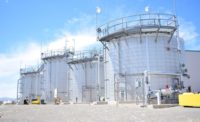The deadline for the U.S. Dept. of Energy to begin getting rid of long-stored radioactive waste at the Hanford nuclear site by starting up a a $17-billion treatment facility has been extended until 2025 by a federal judge. DOE officials say, however, that they remain focused on turning low-level nuclear waste into vitrified glass by the end of next year for long term storage.
In 2020, a judge-directed consent decree was amended to require DOE to start treating waste at the Hanford Waste Treatment Plant by the end of 2023. That extension was due to changes in workforce levels at the plant from impacts of the COVID-19 pandemic. An updated filing now defines the lost time, with the judge adding 579 days to the deadline that pushes mandated operation to August 2025. The Washington State Dept. of Ecology has agreed to the new date.
"With tank waste treatment underway on an industrial scale, [DOE] is working diligently to achieve remaining milestones for tank waste retrieval and treatment in a safe and timely manner," says a department spokesperson. "This amendment simply allows for the DOE and state of Washington agreed-upon extension of milestone dates in the consent decree due to impacts of the coronavirus pandemic."
The Hanford site is one of the nation's worst nuclear waste dumps, with construction of the vitrification plant ongoing since 2002. About 56 million gallons of waste are stored in underground tanks at the former site of major plutonium production for weapons during World War II and the Cold War.
Bechtel has been leading vitrification plant construction and did not have a comment on the extension.
Under an amendment filed in December 2020, one day was added to the deadline for every day Hanford was in phase one of its remobilization plan, which included only mission-critical operations and a maximum telework framework. Three-quarters of a day was added for every day in phase two, which added additional workers to the site. Now that Hanford is fully remobilized in phase three and all field work has resumed, the consent decree amendment was adjusted to signify the calculations.
The federal judge allowed for the date change due to the force majeure clause, meaning the pandemic was an event outside of the control of the DOE and its contractors.
Along with vitrification-plant glass-making, the deadline move allows for new timing in finalizing construction of the low-activity waste portion of the facility, the facility's cold commissioning, hot commissioning of the plant and waste transfer from higher-risk single-shell tanks to safer double-shell tanks.
The Dept. of Ecology "agrees that the pandemic does meet the consent decree's force majeure provisions and [DOE] is entitled to delays for certain milestones under the provision," says Ryan Miller, the department spokesperson, noting five negotiated milestone delays related to work stoppages during the pandemic. "While we believe Energy is entitled to a force majeure extension for start-up, [the low-activity waste facility] can and should stick to its existing consent decree milestones."
Miller says the state environmental department would have preferred DOE to request an extension when the milestone "might actually be at risk." Shifting the timeline now removes any incentive to meet the current 2023 date, he contends.
DOE says it remains fully focused on the goal of making glass by the end of 2023 and aims to mitigate any impacts the pandemic had on schedule to send stored low-level radioactive waste directly to the plant fortreatment.
The facility will produce about 1,100 containers per year that will be stored permanently at the site. Hanford's high-level waste treatment plant will go on line at an unspecified later date, with vitrified waste destined for long-term storage at a to-be-determined national repository.




Post a comment to this article
Report Abusive Comment